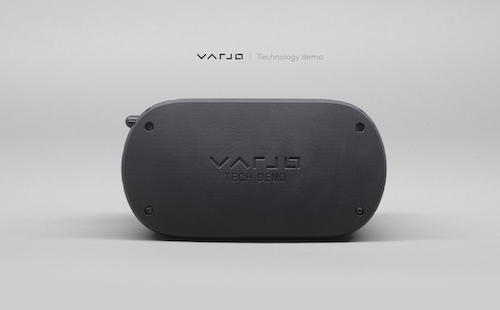Varjo Sets Sights On Human Eye Resolution for VR

The VR/XR Bionic Display leverages micro display technology, a traditional display, and eye tracking software to achieve its human-eye resolution. Image Courtesy of Varjo
Latest News
December 22, 2017
There’s a lot of hyperventilating over augmented reality (AR) and virtual reality (VR) right now, but the truth is most of the current headsets are aimed at the consumer and entertainment markets, offering resolutions that are pretty sub par for commercial engineering and design applications.
Varjo Technologies, a Helsinki startup founded by former employees from Microsoft and Nokia, is trying to change that equation by delivering new levels of VR and Mixed Reality (XR) realism to help unleash the technologies for use in professional applications. Current VR headsets, like Microsoft’s Hololens or the Facebook-owned Oculus Rift, were designed and built with consumer price points in mind, thus they leverage technology used in mobile phones, which sacrifices quality and limits their resolution capabilities, according to Urho Konttori, CEO and founder of Varjo.
 The VR/XR Bionic Display leverages micro display technology, a traditional display, and eye tracking software to achieve its human-eye resolution. Image Courtesy of Varjo.
The VR/XR Bionic Display leverages micro display technology, a traditional display, and eye tracking software to achieve its human-eye resolution. Image Courtesy of Varjo.Varjo set out to tap higher-end micro display hardware and gaze tracking software algorithms to create a higher pixel VR/XR experience for the engineering and design community, among other professional segments. “If you want to see how things actually look, the only way to do that is in a lifelike fashion,” Konttori explains. “We’ve developed a clever engineering innovation using two different displays feeding into one pipeline to pump up resolutions to around 100 times what they are in headsets in today’s markets.”
Varjo worked with some of its biggest clients—global brands such as Airbus, Audi BMW, and Volkswagen—to optimize the company’s human-eye resolution VR/XR Bionic Display for their respective industries. The startup, which is also working with leading graphics chips manufacturers like NVIDIA and AMD to optimize its viewing experience, claims its display technology is capable of human-eye resolution.
Konttori says professional designers and engineers have been trying to use VR for at least two decades to speed up their design and prototyping processes, but have had limited success as the technology wasn’t powerful enough to depict changes on car surfaces instantly, for example, or to display lighting and reflections in any meaningful, lifelike way. “If you can’t see that detail, if you can’t see a reflection or a sharp defining light, you can’t really use it,” he says. “We wanted to push for human eye resolution so VR/XR becomes a real tool for the design process in the automotive industry and for all types of engineering.”
With the Varjo VR/XR Bionic Display, engineers get a higher pixel density display on their VR headset, allowing them to view a split line in a car, for example, to see exactly how it will look as opposed to viewing a pixeled matrix that doesn’t look like a real image, he says. To mimic how the human eye works, the company is marrying a super resolution micro display similar to what is used in a high-end DSLR camera’s view finder with a traditional display that simulates the peripheral vision. Eye tracker and graze tracking software coordinate the two to achieve the ultra-clear view that matches human eye resolution.
 Varjo’s VR headset raises the stakes with technology capable of human-eye resolution. Image Courtesy of Varjo
Varjo’s VR headset raises the stakes with technology capable of human-eye resolution. Image Courtesy of VarjoVarjo is shipping alpha prototypes to customers and plans to release a commercial version of the headset in 2018. Pricing is not finalized, but Konttori says to expect it to land in the $5,000 to $10,000 range per head set. The company is also working with leading CAD vendors and middleware providers to evolve their software to support the new high-resolution head set.
In industries like aerospace and automotive, which have already invested in space-consuming and expensive simulation systems and CAVES, Konttori expects the Varjo VR/XR Bionic Display to be a game changer. “With human eye resolution, it’s now possible to replace those systems for a VR headset,” he says. “The ability to free designers from the restrictions of two dimensional views to see their designs as they will look when finished in the real world is a groundbreaking moment.”
Watch this video to hear Konttori’s presentation on how human-eye resolution VR technology will change the market for design professionals.
Subscribe to our FREE magazine, FREE email newsletters or both!
Latest News
About the Author
Beth Stackpole is a contributing editor to Digital Engineering. Send e-mail about this article to [email protected].
Follow DE





